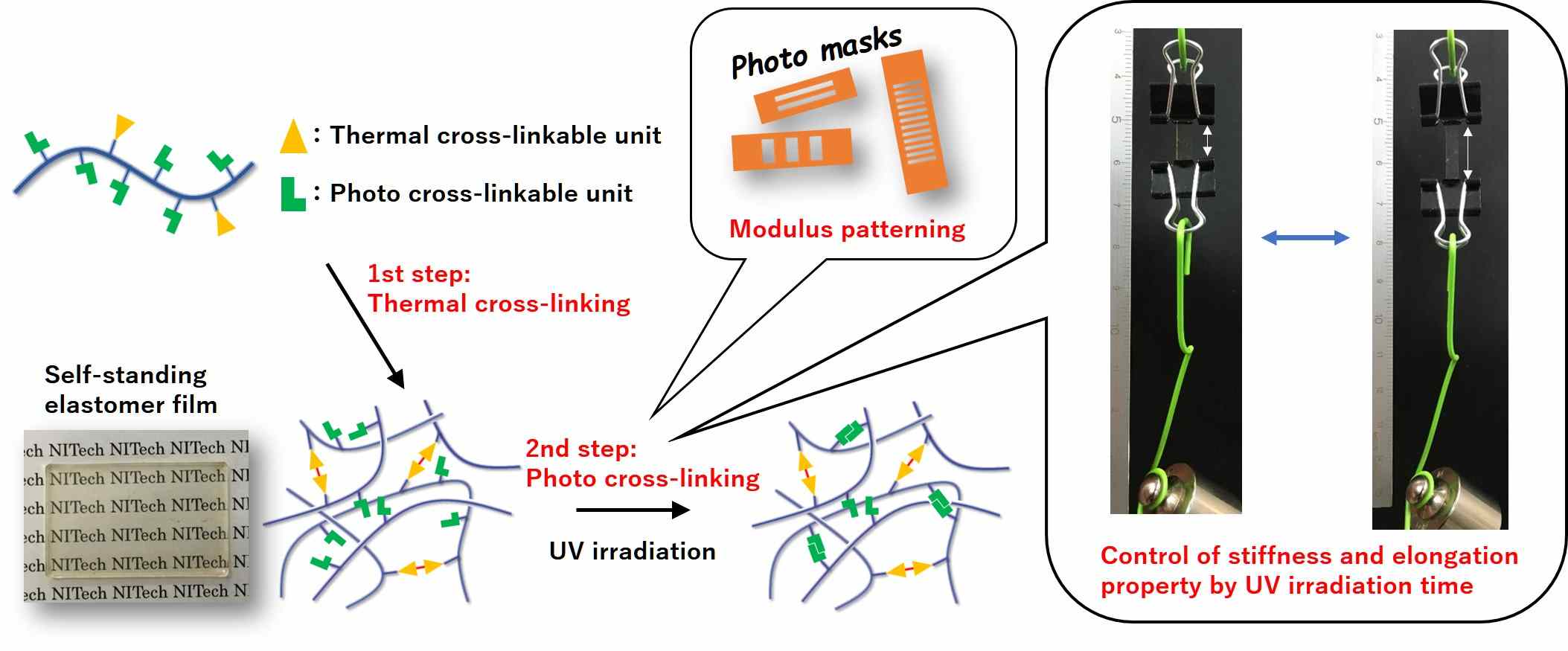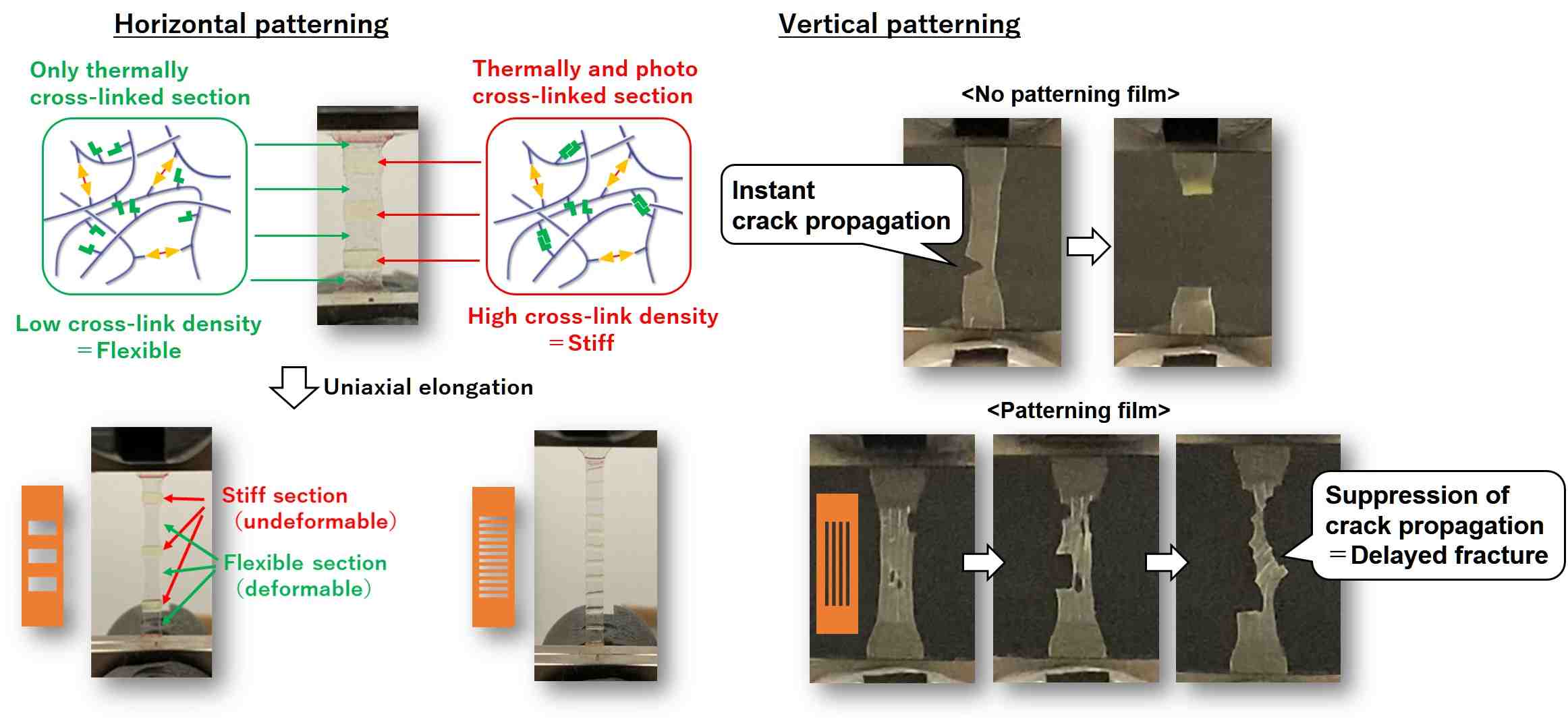RESEARCH NEWS - Scientists Develop Films with Tunable Elongation and Fracture for Various Uses
Category:News|Publishing : September 7, 2021
Elastomers, or elastic polymers, materials with high elasticity, are widely used for applications in industries, such as automotive, manufacturing, and oil and gas. The degree of elasticity in these materials, denoted by a parameter known as "Young's modulus," depends on the extent of cross-linking between the constituent polymer layers such that higher cross-linking leads to higher rigidity, and, in turn, implies a large Young's modulus.
Different applications require elastomers of different stiffness. For instance, the desirable Young's modulus for tires is different from that for pipes and hoses. So far, for conventional elastomers, once the cross-linking of polymer chains takes place, their properties cannot be changed, requiring industries to manufacture different elastomers for different applications. But what if we could prepare a single elastomer with versatile properties for a range of applications?
In a new study published in Polymer, Dr. Mikihiro Hayashi from Nagoya Institute of Technology, Japan, and his colleagues have now done just that. The team has successfully synthesized an elastomer film whose elongation can be controlled by post-preparation photo reaction to suit the desired application, thus, saving time, cost and human resources.
To develop this elastomer, the scientists equipped a polyester (polymer having ester group) with thermoreactive and photoreactive groups, which react to heat and light, respectively. They then followed a two-step process in which the thermoreactive groups first underwent thermal cross-linking and then the photoreactive group formed cross-links in presence of UV light. The scientists observed that the material obtained after thermal cross-linking was soft and flexible, but when further treated with UV light, the material increased in stiffness depending on the time of exposure. In fact, when exposed for 30 minutes, the material's Young's Modulus increased by two orders of magnitude!
This unprecedented finding excited the scientists. Dr. Hayashi states, "By developing this elastomer using the dual thermal and photo cross-linking, we proved that post-preparation tuning of tensile strength in materials is possible. We were intrigued to further explore the benefits of this material."
Accordingly, they designed elastomer films with inhomogeneous patterning of Young's modulus through selective UV illumination. The scientists accomplished this using horizontal and vertical photomasking slits, creating patterns of soft and rigid sections. On testing the horizontal patterned films under stress, the rigid sections hardly showed any deformation, whereas the soft sections showed 5 times elongation. Surprisingly, however, the vertically patterned films showed excellent toughness and delayed the propagation of cracks. While a crack on a fully rigid film propagates instantly, a crack on the inhomogeneous film stopped on reaching the soft section. The more the number of patterns, the slower was the growth of the crack.
"Our findings can provide useful insights for developing new methodologies for controlling the fracture behavior of elastomers," comments Dr. Hayashi, speaking of the practical ramifications of their study. "In addition, our technique could help save excess chemical consumption, and solve problems associated with depletion of petroleum resources," he adds.
These versatile films are sure to find applications in a diverse range of fields and pave the way to sustainable societies!

Figure 1: Dual-Thermal and Photo-crosslinking of polymer chains for synthesis of versatile elastomer
Scientists from Japan managed to develop an elastomer film with tunable elasticity using a two-step thermal and photo-induced cross-linking process that allowed for stiffness control based on the time of exposure to UV radiation.
Courtesy: Mikihiro Hayashi from Nagoya Institute of Technology

Figure 2: Tensile Properties and Crack Behavior in Horizontal and Vertical Patterned Inhomogeneous Elastomers
By selectively illuminating the elastomer film using patterned photomasking slits, the scientists manufactured vertically patterned films that showed an interesting fracture behavior characterized by a suppression of cracks at the soft sections.
Courtesy: Mikihiro Hayashi from Nagoya Institute of Technology
Reference
|
Title of original paper |
Versatile tensile and fracture behaviors of dual cross-linked elastomers by postpreparation photo tuning of local cross-link density |
|
Journal |
Polymer |
|
DOI |
About Assistant Professor Mikihiro Hayashi
Dr. Mikihiro Hayashi is an Assistant Professor in the Department of Life Science and Chemistry at Nagoya Institute of Technology (NITech), Japan. He completed his Ph.D. from Nagoya University in 2015. His field of expertise is the creation and physics of functional polymers. As a young and vibrant researcher, Prof. Hayashi has 38 publications to his credit with over 200 citations.
Funding information
This study was supported by a research funding granted by the Eno Science Foundation.
Contact
Assistant Professor Mikihiro Hayashi
Email: hayashi.mikihiro[at]nitech.ac.jp
TEL: +81-52-735-7159
Links: Hayashi Lab.
*Please replace [at] with @ when contacting .
RESEARCH NEWS - Plumbing the Depths: Defect Distribution in Ion-Implanted SiC Diodes Collaborative Project with Coimbra University (Portugal) was Selected

 Japanese
Japanese